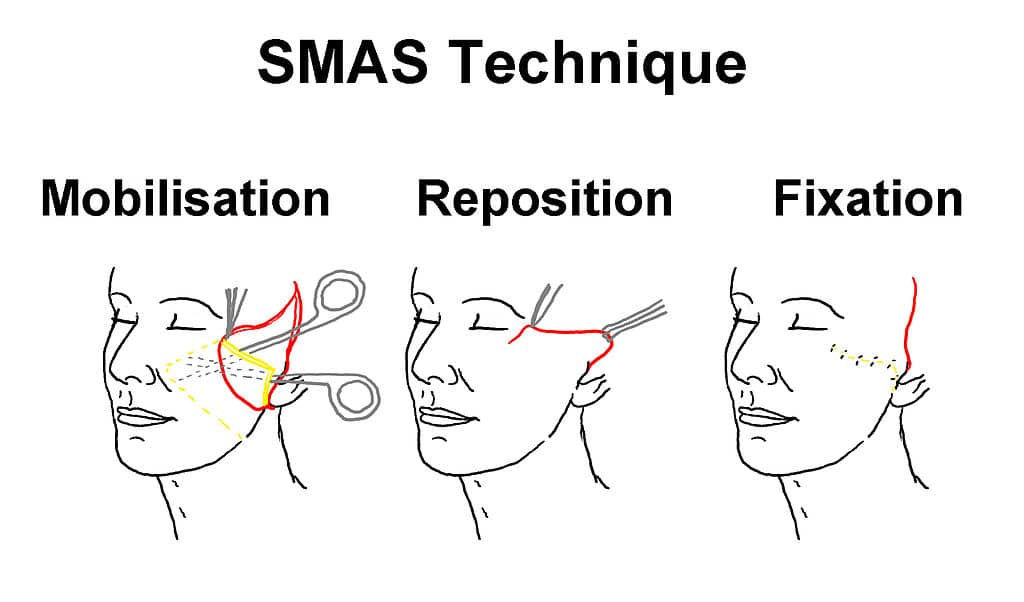Facelift, also known as a rhytidectomy is a surgical procedure that lifts and tightens the facial tissues. As we get older, skin and tissues naturally lose their elasticity. This leads to sagging and wrinkles.
A facelift helps to give a more youthful facial appearance. Other methods that give a youthful facial appearance include Botox, exercise routines tone underlying facial muscles and liposculpture.
Reasons for facelift
A facelift is performed to rejuvenate the appearance of the face. The aging of the face is most shown by a change in position of the deep anatomical structures, notably the platysma muscle, cheek fat and the orbicularis oculi muscle. These changes give the aging appearance.
The ideal age for face-lifting is at age 50 or younger, as measured by patient satisfaction.
Surgical Procedure for a facelift
The operation takes about two to three hours and is performed with the patient under general anesthesia. There are different surgical procedures for facelift depending on the type of incision, the extent of surgery and the area of the face that is treated.
The surgeon will consult with the patient to determine the best procedure for optimal results.
The common surgical procedures are:
1. Traditional facelift
In the traditional facelift, an incision is made in front of the ear extending up into the hairline. The incision curves around the bottom of the ear and then behind it, usually ending near the hairline on the back of the neck. After the skin incision is made, the skin is separated from the deeper tissues with a scalpel or scissors (also called undermining) over the cheeks and neck.
The excess skin is then removed, and the skin incisions are closed with sutures and staples.
2. Mid-face-lift
The mid-face area, the area between the cheeks, flattens and makes a woman’s face look slightly more masculine. The mid-face-lift is suggested to people where these changes occur, yet without a significant degree of jowling or sagging of the neck. In these cases, a mid-face-lift is sufficient to rejuvenate the face as opposed to a full facelift, which is a more drastic surgery.
The recovery time is rather short and this procedure is often combined with a blepharoplasty (eyelid surgery).
3. Mini facelift
Patients who exhibit a mild degree of jowling and sagging skin are often good candidates for a mini-facelift.
This is a less invasive technique that allows a cosmetic surgeon to tighten deep facial tissues through shorter incisions, typically located along the hairline above each ear and/or in the natural creases surrounding the ear.
Through these incisions, structural tissues around the cheeks are lifted and tightened to correct jowling, refine the jawline, and rejuvenate a “tired” appearance.
Depending on the case, a mini-facelift may be performed using local anesthesia with sedation or general anesthesia; your cosmetic surgeon will recommend the best option for your individual needs. A mini-facelift can help you address unwelcome signs of aging before they become too pronounced, postponing the need for more extensive surgery for many years.
4. SMAS Lift

The technique of a SMAS (Superficial Musculo Aponeurotic System) facelift, consist of mobilization, repositioning and fixating.
Other types of facelift techniques involve modifications to the above techniques including Composite Facelift, Deep-plane facelift, Skin-only facelift, etc.
Facelift Risks and Complications
As with other types of surgery, there is a risk of complications with the facelift procedure. Some complications associated with a facelift are:
- Bleeding – This is the most common complication and usually requires a return to the operating room.
- Infection – Infections may result from bacteria, viruses, fungi and other pathogens.
- Nerve injury – This can be sustained during rhytidectomy. This kind of injury can be temporary or permanent and harm can be done to either sensory or motor nerves of the face. As a sensory nerve, the great auricular nerve is the most common nerve to get injured at a facelift procedure. The most injured motor nerve is the facial nerve.
- Hematoma – This is the most seen complication after a facelift. It usually results within the first 24hours after surgery.
- Hair loss – Hair loss in the portions of the incision within the hair-bearing scalp can rarely occur. A hairline distortion can result after undergoing a rhytidectomy. Especially facial hair by men after a facelift procedure. There is a high incidence of alopecia after rhytidectomy. See Hair Transplant Surgery
Facelift Surgery Cost
The total cost for facelift surgery depends on a lot of factors such as the anesthetic fee, private hospital fee, private operating facility fee, the extent of surgery required.
The total cost of the procedure is around $7500 – $15,000.


